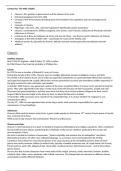Context for ‘The Wife of Bath’
Chaucer’s life, position in government and the themes of his work
Historical background of 1327-1400
Concept of the Three Estates (breaking away from feudalism into capitalism and new emerging social
classes)
Concepts of chivalry
Pilgrimage: who went, why, and what happened? Specifically London-Canterbury
Chaucer’s contemporaries (William Langland, John Gower, Jean Froissart, Guillaume de Machaut) and their
influences on Chaucer
La Roman de la Rose by Guillaume de Lorris and Jean de Meun – key themes and its influence on Chaucer
Analogues of the Wife of Bath’s tale – specifically the issues of the loathly Lady
Medieval women (La Querelle des femme, attitudes towards women generally and attitudes towards
widows)
Chaucer:
Geoffrey Chaucer:
Born 1342/43, England—died October 25, 1400, London.
By 1366 Chaucer had married, probably to Philippa Pan.
Career:
By 1359 he was a member of Edward III’s army in France.
During the decade of the 1370s, Chaucer went on multiple diplomatic missions in Belgium, France, and Italy.
He worked in the Customs House and in 1382 was appointed comptroller [a royal-household official who examines
and supervises expenses or a public official who reviews government accounts and sometimes certifies expenses] of
the petty customs for wine and other merchandise.
In October 1835 Chaucer was appointed a justice of the peace [a judicial officer of a lower court, elected to keep the
peace. They were appointed by the king, not the local community because of their local power, wealth and rank.
They were not great proprietors, and they were local, but they were not just ordinary villagers] for Kent, and in
August 1386 he became knight of the shire for Kent, to attend Parliament in October.
In December 1386 successors were named for his comptrollerships, it is unclear whether he resigned or was
removed from office.
On July 12th, 1389, he was appointed clerk of the king’s works, with executive responsibility for repair and
maintenance of royal buildings.
Influences:
Chaucer often used the dream-vision form, a genre made popular by the famous 13 th century French poem of courtly
love, le Roman de la Rose.
While away in Italy Chaucer discovered Dante, Petrarch and Boccaccio.
Themes and style:
Chaucer is most famously a love poet, he looked at important philosophical and religious questions, often considered
human frailty and was always questioning the complexity of the human condition, particularly the secular and
eternal aspects of love.
His style is marked by freedom of expression, “joyous originality and easiness free of ambiguities” and direct
philosophical maxims. He often uses colloquial language, so a common man could understand his writing.
Canterbury Tales allows for many literary genres to be used, because of the storytelling contest. Some of these
genres are courtly romance, fabliau [a metrical tale, typically a bawdily humorous one, of a type found a lot in early
French poetry], saint’s life, allegorical tale, beast fable, medieval sermon, alchemical account – and at times these
genres mixed.
He was also able to have characters from many walks of life: knight, prioress, monk, merchant, lawman, franklin,
scholarly clerk, miller, reeve, pardoner, wife of Bath, and more. This allowed him to comment on different classes
and prejudices within different lifestyles.
,The main themes of Canterbury Tales are:
Social satire
Competition
Courtly love and sexual desire
Friendship and company
Writing and authorship
Class
Lies
Religion and church corruption
Famous works:
The Book of the Duchess
The House of Fame
Anelida and Arcite
Parlement of Foules
Troilus and Criseyde
The Legend of Good Women
The Canterbury Tales
Historical background:
Edward II 1307-1327
Edward III 1327-1377
Richard II 1377-1399
After the Despenser War (1321-22) there was instability and the overthrow and possible murder of Edward II by his
French wide, Isabella, and a rebel baron, Roger Mortimer. However, their regime only lasted a few years before
there was a coup led by Edward III in 1330.
Edward III tried to restore royal power, but during the 1340s the Black Death arrived in England and the losses and
recurring plagues affected events in England for many eras. During this, Edward III made a challenge for the French
throne, resulting in English forces fighting many campaigns in a long-running conflict – the Hundred Years’ War.
There were challenges with raising the finance to pay for the war, but Edward’s military successes brought lots of
stolen wealth to lots of England – which enabled substantial building work by the king.
Edward III restored order with the help of a majority of the nobility, exercising power through the treasury the
common bench and the royal household. This government was better organised and on a larger scale than ever
before. Edward used Parliament even more than previous kings to handle general administration, to legislate and to
raise the necessary taxes to pay for the wars in France.
He held elaborate chivalric events in an attempt to unite his supporters around the symbols of knighthood, and there
was an increase in knightly orders, grand tournaments and round table events.
Richard II faced political and economic problems – mostly because of the Black Death. For example, in 1381 there
was the Peasants’ Revolt that broke out across the south of England because of the introduction of the unpopular
poll tax of 1380, which exposed the economic discontent that had been growing since the middle of the century.
Richard II ceded to the peasants’ demands and the poll tax was abandoned, restrictions on labour wages were not
strictly enforced, and peasants continued the trend of buying their freedom out of serfdom [a serf was an
agricultural labourer bound by the feudal system who was tied to working on his lord's estate] and becoming an
independent farmer.
Over the next few decades, Richard II and groups of nobles struggled to gain power and control of policy towards
France until Henry of Bolingbroke seized the throne with the support of Parliament in 1399. Ruling as Henry IV, he
exercised power though a royal council and Parliament, while attempting to enforce political and religious
conformity.
Society and government in England were challenged by the Great Famine [heavy rains that lasted a few months in
1315 meant fields couldn’t be ploughed; crops died because of rotting; livestock drowned, died from diseases spread
, by the water or simply because of starvation. It impacted most of Europe from 1315-1317, with roughly one million
people dying] and the Black Death [bubonic plague that spread across Europe from 1347-1351 that killed roughly 25
million people]. The economic crisis created a sudden excess of land, undermining the ability of landowners to exert
their feudal rights and causing a collapse in incomes from rented lands. Wages soared as employers competed for
scarce workforce. Statute of Labourers, 1351, was introduced – it limited wages and prevented lower class from
buying luxury goods, with prosecutions coming to take up most of the legal system’s energy and time. A poll tax was
introduced in 1377 that spread the costs of war with France more widely across the population – this poll tax was
what caused the Peasants’ Revolt
Three Estates:
What is Feudalism?
Feudalism was the dominant social system in medieval Europe, in which the nobility held lands from the Crown in
exchange for military service, and vassals were in turn tenants of the nobles, while the peasants (villeins or serfs)
were obliged to live on their lord's land and give him homage, labour, and a share of the produce, notionally in
exchange for military protection.
The Three Estates:
The Feudal society of France was traditionally split into three estates (or factions). The First Estate represented the
Church, the Second Estate consisted of those who were noble (excluding the King), and the Third Estate housed the
rest of society, from peasants to the bourgeoisie - the wealthy business class who usually owned property or ran a
business. Yet, women were further separated into different “feminine estates”: virgin, wife or widow. A woman’s
estate was based entirely on their sexuality; their relationship, or lack of, with men define their place in society.
Exempt from taxes were the First and Second Estates (with the exception of a few nobles who payed modest taxes).
The Third Estate, however, (which consisted of around 27 million people, or 98 percent of the French population)
was subject to hefty taxes, called the taille (some bourgeoisie were exempt due to some taxes due to their status), in
which funded most of the Royal family’s wealth. Even more so, the Church collected their own separate tax from
both peasants and nobles - this was the tithe, in which 1/10 of a person’s income must be payed to the clergy.
Despite the Third Estate’s enormous size and economic importance, it played almost no role in the government or
decision-making of the Ancien Regime. The frustrations, grievances and sufferings of the Third Estate became pivotal
causes of the French Revolution.
• The peasantry made up about 82 percent of the population; farmers who owned their own land were the yeoman,
who were obligated to pay additional land tax.
• Other members of the Third Estate were confined to France’s towns and cities. Most commoners in the towns and
cities made their living as merchants, skilled artisans or unskilled workers. Artisans worked in industries like
textiles and clothing manufacture, upholstery and furniture, clock making, locksmithing, leather goods, carriage
making and repair, carpentry and masonry. Unskilled labourers worked as servants, cleaners, hauliers, water
carriers, washerwomen, hawkers etc. Many Parisians, about as many as 80,000 people, had no job at all: they
survived by begging, scavenging, petty crime or prostitution.
The lives of urban workers became increasingly difficult in the 1780s. Parisian workers toiled for meagre wages:
between 30 and 60 sous a day for skilled labourers and 15-20 sous a day for the unskilled. Wages rose by around 20
per cent in the 25 years before 1789, however prices and rents increased by 60 per cent in the same period.
The poor harvests of 1788-89 pushed Parisian workers to the brink by driving up bread prices. In early 1789, the
price of a four-pound loaf of bread in Paris increased from nine sous to 14.5 sous, almost a full day’s pay for most
unskilled labourers.
In spite of this, the bourgeoisie flourished during the 1700s, due in part to France’s economic growth, modernisation,
increased production, imperial expansion and foreign trade. The haute bourgeoisie rose from the middle classes to
become independently wealthy, well-educated and ambitious.





